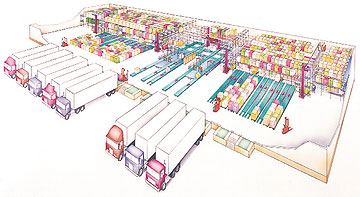Cross-Docking: What are the facility layout considerations?
How can an older facility be retrofitted for cross docking applications?
This is the third in a series of articles on cross-docking

If you started from scratch, many might simply build a cross-dock facility with a much shallower depth than most warehouses. A depth of a hundred feet or so, with incoming product on one side that can be easily moved a short distance and loaded on the other side to an outbound truck. Most of us must deal with an existing facility, many times a large square box which is not generally the preferred layout. However, as long as the existing facility has a sufficient quantity of dock doors, yard space, and an adequate footprint, you may be fine.
It’s more than dock doors
Simply having a lot of dock doors does little for efficiency if the doors are located on opposite walls at a great distance from one another. Conveyor companies might love this, but there are better alternatives. Some recommend all the doors on one wall, or even at 90 degrees to one another. High-speed movers would then travel between incoming and outgoing doors in closest proximity to one another. Proximity of high traffic incoming and outgoing doors is key. Distance equals costs. Many consider dedicating only a portion of their facility for cross-dock duties as an acceptable workaround.
Pallet handling versus case handling creates separate requirements. Congestion in dock areas will be a killer. Sufficient dock space is key to moving products quickly and safely. This is particularly true if the company is growing or deals with seasonal products. Ample space must be available for any pallet staging activities near shipping doors. If aisles are part of your logical pathways, then oversize them in high-traffic areas.
Shape matters
One of the more complete reviews of cross-dock design is by John Bartholdi and Kevin Gue in Transportation Science. They provide an analysis of the impact of “shape” on the performance of a cross-dock operation. They considered a wide variety of designs and freight flow patterns, and offered the following summary:
“Shape matters. Freight must be moved across the dock and the total distance traveled is a good estimate of labor costs. The best shape for small to mid-sized cross docks is a narrow rectangle or I-shape, which gets maximum use of its most central doors. For larger docks, alternative shapes are more attractive. The best shapes for larger docks will have piers branching out from a central area. These designs have more corners, for which they pay a cost. However, they achieve greater centrality, and so more distant doors are closer to other doors. For example, the T-shape is best for dock sizes between about 150 to 200 doors. For larger than 200 doors, the X-shape is best. Despite having four inside corners near the center of the dock, the worst doors are not far from the center. When freight flows are concentrated among few destinations, the point will be deferred at which a more complicated design becomes attractive. This is because the labor will be concentrated on a subset of the dock, and so the dock is, in effect, a smaller dock.”
Layouts designed on solid principles will address the “layout issue”. Although we have been focusing on the internal logistics of cross-docking, we do need to make note of another obvious area of interest…. the “trailer spotting” issue. A poor spotting process defeats a quality layout. They work in concert. There are many issues you deal with in creating an optimum design for cross-docking. In the next brief, we will take a look at cross-docking in actual practice. This will include a couple of applications that deal with the issues we have discussed, and others. One application is complex, the other is a simple scalable system (actually including system costs).

Tags: order fulfillment, Supply Chain, cross dock, Cross Docking, dock layout, conveyor systems, advanced shipping notice
Scott Stone is Cisco-Eagle's Vice President of Marketing with more than thirty years of experience in material handling, warehousing and industrial operations. His work is published in multiple industry journals an websites on a variety of warehousing topics. He writes about automation, warehousing, safety, manufacturing and other areas of concern for industrial operations and those who operate them.



